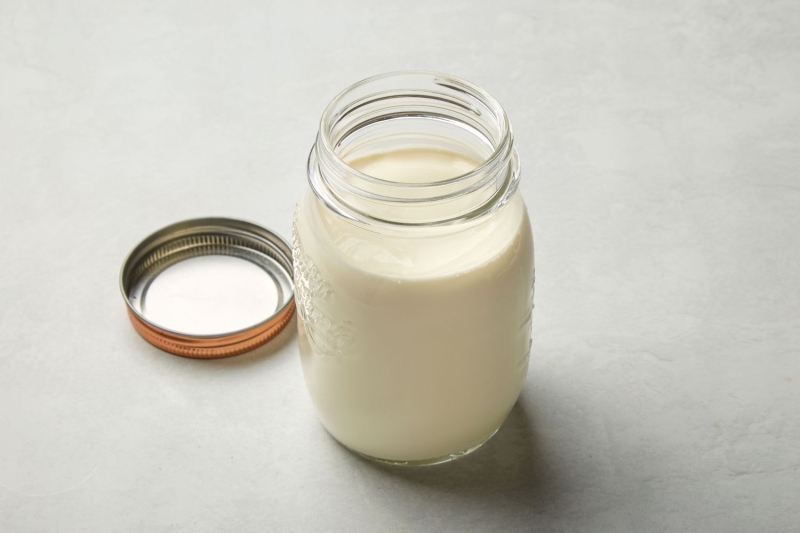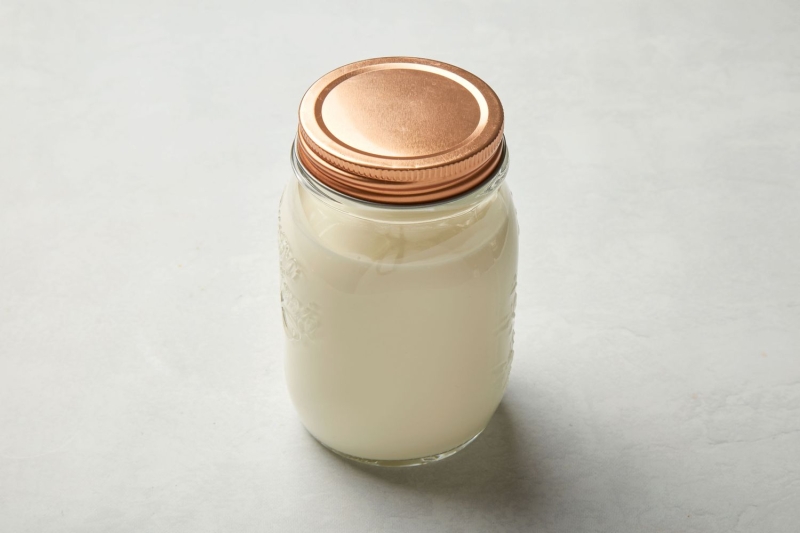Prep: 5 mins
Cook: 0 mins
Culturing: 36 hrs
Total: 36 hrs 5 mins
Servings: 8
Yield: 2 cups
Crème fraîche, translated from French as "fresh cream," is a luxuriously thick cultured cream. Despite its French name, which makes it sound extra fancy, preparing it is simple, and it is incredibly versatile in both cooking and baking. Cultured cream originates from cow's cream that undergoes fermentation with a bacterial culture, resulting in a texture closely resembling sour cream.
Although you can use crème fraîche immediately after the fermentation process, allowing it to chill in the refrigerator allows the flavors to develop and the texture to firm up. Don’t over-stir the crème, as it can quickly loosen.
What’s the Difference Between Crème Fraîche and Sour Cream?
Crème fraîche is similar to sour cream with a lower acidity level and a higher fat content. Additionally, there’s Mexican crema, which is not quite as thick. If we were to arrange them based on acidity levels, sour cream would rank first, followed by Mexican crema, with crème fraîche being the least acidic. This makes it ideal for dishes where you need a gentle, rich, and creamy texture without overwhelming the overall flavor profile.
How To Use Crème Fraîche
Crème fraîche plays equally well with sweet and savory dishes, imparting an enlivening tang to a soup or balancing the sweetness in a cake. Stir herbs, extracts and flavorings, or your favorite spices into crème fraîche to give it a nudge in either direction.
- Vanilla Bean Crème Fraîche — Stir in vanilla bean paste and a sweetener such as honey or powdered sugar.
- Herbed Crème Fraîche — Stir chopped mixed fresh tender herbs (such as chives, dill, tarragon, and/or parsley), fresh lemon juice, and salt and black pepper to taste into crème fraîche. Use the spread as a dip or as a cooling side to grilled meat.
- Berry Crème Fraîche — For fruity sweetness, swirl in your favorite jam or preserves, macerated berries, or freeze-dried fruit powder.
- Crème Fraîche Dip with Old Bay — Combine crème fraîche, mayonnaise, fresh lemon juice, finely chopped shallots and celery, dill, Old Bay seasoning, and whole-grain mustard. Serve with boiled shrimp.
- Crème fraîche has a very high-fat content so it won’t break at high temperatures; add a dollop to soups, scrambled eggs, or pan sauces to enrich them.
Recipe Tips
- Pasteurization matters—Crème fraîche made from pasteurized cream will thicken quicker than crème fraîche made from ultra-pasteurized cream. If you’re lucky enough to find pasteurized cream (it will likely be from a local dairy), it will take between 12 to 24 hours to thicken.
- Use a non-reactive container—Reactive cookware is made from aluminum, cast-iron, and copper. Acidic foods cooked in reactive cookware pick up a metallic flavor. As crème fraîche ferments, it becomes more acidic thanks to lactic acid bacteria and can then pick up undesirable flavors from the container it is being fermented in.
- Stir it back in—Crème fraîche forms a thin skin while fermenting whether you cover it or not, but it’s more noticeable when not covered. Either way works, and this skin can just be stirred back in.
- Ferment at warm room temp—The ideal temperature range for culturing crème fraîche is between (70 F to 75 F). Colder temperatures will increase the fermentation time.
Ingredients
-
2 cups ultra-pasteurized heavy whipping cream
-
2 tablespoons cultured buttermilk (whole milk or low fat)
Steps to Make It
-
Gather the ingredients.

-
Stir together 2 cups ultra-pasteurized heavy whipping cream and 2 tablespoons cultured buttermilk (whole milk or low fat) in a small non-reactive container, such as a glass mason jar. Cover with a lid or cheesecloth and let stand at room temperature until thickened, 24 to 36 hours.

-
Cover and refrigerate 12 hours before serving. Crème fraîche will continue to thicken as it chills. Refrigerate in an airtight container for up 2 weeks.

How to Store Crème Fraîche
Crème fraîche can be refrigerated in an airtight container for up to 2 weeks. Do not freeze.
Uses for Leftover Buttermilk
Incorporate leftover buttermilk into mashed potatoes, pureed soups (add it off the heat or it will curdle), creamy salad dressings, baked goods, dips, marinades (fried chicken), or pancake batter. You can also freeze leftover buttermilk in ice cube trays and then transfer the cubes to zip-top bags for long-term storage. Thaw cubes in the refrigerator overnight and stir before using.
| Nutrition Facts | |
|---|---|
| Servings: 8 | |
| Amount per serving | |
| Calories | 205 |
| % Daily Value* | |
| Total Fat 22g | 28% |
| Saturated Fat 14g | 69% |
| Cholesterol 68mg | 23% |
| Sodium 20mg | 1% |
| Total Carbohydrate 2g | 1% |
| Dietary Fiber 0g | 0% |
| Total Sugars 2g | |
| Protein 2g | |
| Vitamin C 0mg | 2% |
| Calcium 44mg | 3% |
| Iron 0mg | 0% |
| Potassium 62mg | 1% |
| *The % Daily Value (DV) tells you how much a nutrient in a food serving contributes to a daily diet. 2,000 calories a day is used for general nutrition advice. | |


